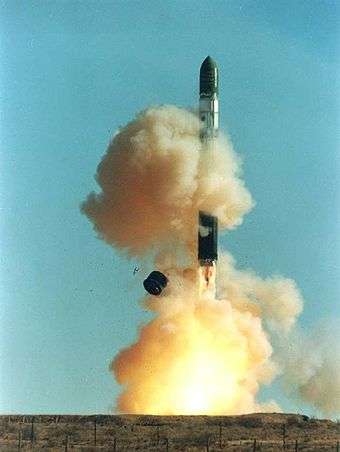Heavy ICBM
Heavy ICBM is a term that was created in the 1970s to describe a class of Soviet and Russian ICBMs (intercontinental ballistic missiles).[1] They were characterized by a heavy throw-weight of 5 to 9 metric tons, several times that of an LGM-30 Minuteman, and a length of over 35 meters, and were thus capable of delivering a large number of warheads in a single MIRV missile.

This term usually refers to R-36 / "SS-9 Scarp",[2] R-36M (SS-18) variants / "SS-18 Satan",[1][3] and the RS-28 Sarmat / "SS-X-32 SNOWFLAKE" missiles.
RS-28 Sarmat is called a "superheavy" ICBM.[4] Superheavy ICBMs date back to the UR-500 which was designed to deliver the 50 megaton (potentially, 100 megaton) Tsar Bomba warhead. The UR-500 was developed into the Proton which successfully launched the first living beings to visit the Moon and return safely, on Zond 5 (Zond-Proton had demonstrated the capability to get cosmonauts to the Moon on this flight, though there was a significant probability that the entry and landing would not have been survivable. Adapting ICBM boosters for human spaceflight had a legacy that goes back to the beginning, including the Titan ICBM for Gemini, the Atlas ICBM for Mercury, and the Soviet R-7 for the first human orbital missions. And even with suborbital missions, the Redstone of Project Mercury was a US Army IRBM. President John F. Kennedy privately explained to NASA Administrator James Webb that the purpose of the human spaceflight program was as "a test of the system".[5][6])
Deliveries
The SS-9 was a silo-launched missile capable of delivering warheads of 5–18 megatons, with a range of up to 15,500 km.[7] These were then replaced by the similar SS-18, with payloads of 18–25 megatons. The silos used for launching were the same for both, once modified.
References
- Graham, Thomas, Jr.; Damien J. La Vera (2003). Cornerstones of Security: Arms Control Treaties in the Nuclear Era. University of Washington Press. pp. 336 et al. ISBN 9780295982960.
- "R-36 / SS-9 SCARP". www.fas.org. Retrieved 19 October 2012.
- "R-36M / SS-18 SATAN". www.fas.org. Retrieved 19 October 2012.
- https://www.rt.com/news/363981-russian-icbm-sarmat-missile/
- 1Transcript of Presidential Meeting in the Cabinet Room of the White House, 21 November 1962
- Listening In: JFK on Getting to the Moon (November 21, 1962) (JFK Library, YouTube, published on Oct 11, 2012)
- "SS-9". www.missilethreat.csis.org. Retrieved 19 October 2012.